According to the Society of Automotive Engineers, a hybrid vehicle can be defined as that vehicle with two or more energy storage systems which must provide power to the propellant system either together or independently. Similarly, the heavy duty hybrid vehicles group indicates that a hybrid vehicle must have at least two energy storage systems and energy converters. In practice, a hybrid electric vehicle (HEV) combines the great autonomy of conventional vehicles with spark ignition engines, compression ignition engines, fuel cells and solar panels with the speed, performance and environmental advantages of electric vehicles, obtaining an automobile with lower fossil fuel consumption and lower pollutant emissions to the atmosphere.
- hybrid electric vehicle
- ignition engines
- thermodynamic models
- autonomy
- hybrid configuration series-parallel-mixed
- hybridization
- micro-hybrid
- mild-hybrid
- full-hybrid
1. Introduction
Nowadays, low pollutant mobility throughout the world is being substantially developed and promoted, especially focusing on the automotive segment [1][2]. In this regard, the transport sector represents one of the main sources of air pollution [3], especially by contributing carbon monoxide, unsmoked hydrocarbons and nitrogen oxides ( N O x ) [4][5]. Because of the increasing importance given to pollution concerns, many efforts have been conducted in recent years to develop different techniques and approaches to minimize gas emissions caused by the mobility sector [6][7]. Thereby, the automotive industry is experiencing a deep transformation towards electric-based mobility [8][9]. This trend is provoking leading brands to be oriented to this new sector, by developing a plethora of novel vehicle models [10]. In this context, the launching of the Toyota Prius in December 1997 [11] was a first milestone that was followed in 1999 with the Honda Insight, a semi-hybrid with manual change or CVT of reduced size and weight, with a low fuel consumption and optimized aerodynamics [11][12]. At the same time, environmental anti-pollution laws are evolving to address the incoming environmental issues in order to safeguard ecosystems and people’s health [13]. Such is the case of the Euro standards, which are regulating key aspects such as emission bounds since 1988 [14]. Consequently, unlike the Japanese and American automotive markets which have objectives of manufacturing gasoline hybrid vehicles, hybrid solutions with diesel engines have been profusely studied in the European market by leading brands such as Citroën, Opel and Peugeot [12].
In general, pure electric vehicles have limited autonomy [15] (see Table 1 and Table 2 ), due to the low energy density of batteries [16] (see Table 3 ) compared with conventional liquid fuels for internal combustion engine (ICE) vehicles. The autonomy depends on the capacity of the batteries and the type of driving, but currently, with the advances of automotive technology, autonomies from 800 to 1000 km can be achieved [17][18], while the zero emissions autonomy (pure electric) ranges from 60 to 75 km. Most of commercial vehicles are plug-in (see Table 2 ), because their larger battery capacity and simpler recharging process compared with conventional hybrids [19][20]. On-board electric storage is normally composed by Li-ion batteries with a capacity 13–18 kWh (see Table 2 ). On the other hand, electric vehicles often have long recharging times. Nevertheless, fast and ultra-fast recharging technologies are emerged which enable recharging times about <30 min [21]. Nonetheless, this kind of infrastructures is still limited.
In addition, many countries do not yet dispose of a sufficiently large network of recharging stations [22][23]. These limitations have supposed a formidable barrier to the widespread usage of pure electric vehicles. However, this trend is expected to be changed in a near future [24]. In this context, HEVs suppose a formidable alternative to pure electric vehicles. As commented, this development will be motivated by the implantation of more restrictive normative. For example, additional taxes on fuel consumption are being imposed in numerous European countries such as Spain [25]. In addition, there exists a continuous evolution on batteries technologies. For each generation, new technologies are developed for large-scale electric storage [26][27][28][29]. This research effort will have a direct impact on the large implantation of electric vehicles. As an example, one critical aspect in the automotive sector is the total weight of the storage system. This feature is strongly determined by the energy density of a battery technology, which is defined as the total weight (in kg) necessary to store 1 Wh. Figure 1 shows the evolution of this characteristic in recent years and the expected trend over a 20-year horizon for different technologies. As seen, emerging technologies such as Li-ion batteries are expected to offer very attractive characteristics for the automotive sector [16][30][31]. Other promising research areas are focused on designing states or specific power trains configurations for HEVs [32][33][34][35].
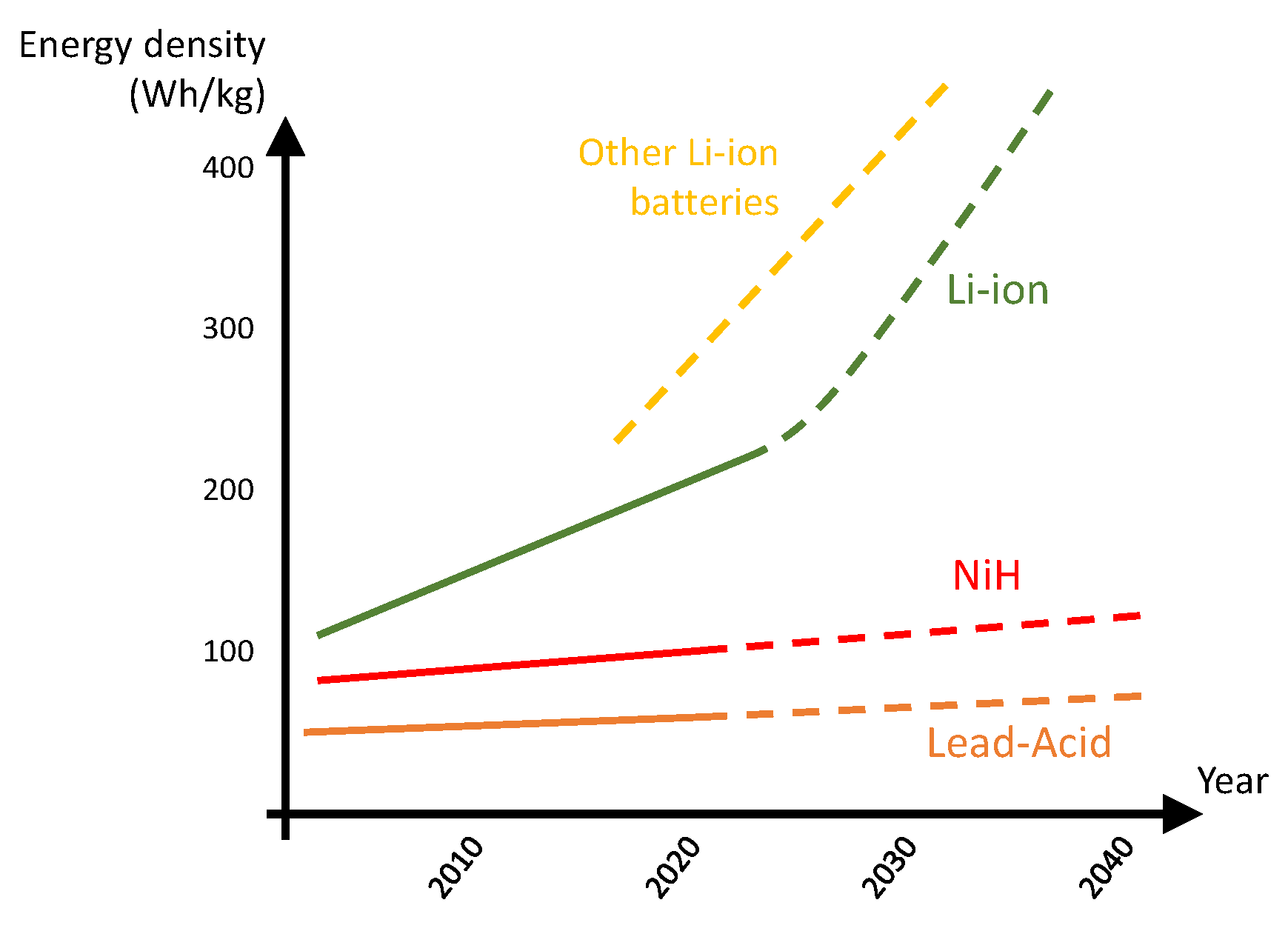 Figure 1. Energy density feature for various typical battery technologies in automotive sector and expected future trend (adapted from [29]).
Figure 1. Energy density feature for various typical battery technologies in automotive sector and expected future trend (adapted from [29]).
| Fuel | Vehicle Model | Driving Range (km) | Annual Fuel Cost (USD) | |
|---|---|---|---|---|
| Electric Autonomy (km) | Batteries | Type | Compact and Small | Mid and Large |
| All electric | 94–360 | 320–650 | 600–950 | |
| Fuel/Technology | Energy Density (MJ/kg) | ||||
|---|---|---|---|---|---|
| Mercedes Class A 250e | 77 | Li-ion 15.6 kWh | |||
| Gasoline | 45 | ||||
| Plug-in hybrid | 500–800 | 480–1000 | 750–2800 | ||
| Diesel | 45 | Fuel cell electric | 570 | 600 | NA |
| Ethanol | 450–660 | 480–860 | 1900–2900 |
| Plug-in | |||||
| Toyota RAV4 Plug-in Hybrid | 75 | Li-ion 18.1 kWh | Plug-in | ||
| Suzuki Across | 75 | Li-ion 18.1 kWh | |||
| Hydrogen | 120 | Plug-in | |||
| Volkswagen Golf eHybrid | 71 | Li-ion 13.0 kWh | Plug-in | ||
| Lead-Acid | 0.11–0.18 | Mercedes B 250 e | 70 | Li-ion 15.6 kWh | Plug-in |
| Li-ion | 0.54–1.08 | Mercedes CLA 250 e | 69 | Li-ion 15.6 kWh | Plug-in |
| NiCd | 0.11–1.26 | Range Rover Evoque P300e | 66 | Li-ion 15.0 kWh | Plug-in |
Besides the electrical part of an HEV, the conventional combustion layout is still present in current HEV models. The combustion components are expected to have a vital importance in future HEVs, helping to overcome the limitations of purely electric vehicles. In this sense, the combustion system is still necessary for extending the autonomy offered by the electric counterpart. In addition, electricity cost in many countries is still quite high and few competitive with traditional fuel prices. In this context, vehicle manufacturers and researchers have developed many configurations for coupling both systems. The various configurations with the application of a heat engine and an electric traction in an HEV seek significant improvements in autonomy, as the heat engine has the mission of recharging the batteries in a standard configuration and provides the propulsion force in conditions of constant running and overtaking.
2. Classification of HEVs
Customarily, the HEVs can be classified according the hybridization level and architecture. The first category makes reference to the degree of electrification of the vehicle, in other words, the greater importance of the electrical part the high degree of hybrid the vehicle is. While the second category is more referred to the components involved in the vehicle and the way in which they interact among them.
2.1. Classification by hybridization level
2.1.1. Micro Hybrid
The vehicles in this classification encompass the alternator and the start button in the same set. A small electric motor is other key feature of this kind of vehicles. In this sense, the engine only serves to charge the battery system as much as possible during braking phases, besides providing the so-called ‘Stop and Start’ service, which is devoted on restoring the heat engine before starting the running. In this sense, any automobile that provides such kind of capability could be encompassed into this category. One highlight of the ‘Stop and Start’ service is the moment during which the engine is put on below 6 km/h,and starts automatically with the help of the electric motor when it needs to accelerate again. Finally, it is worth remarking that vehicles within this category usually present a petrol economy between 5% and 8%.
2.1.2. Mild Hybrid
In the second category, the mild-hybrid vehicles have a more powerful electric motor and are usually equipped with a higher capacity battery system. This configuration allows the electric system supports the heat engine even during acceleration. However, the electric counterpart is still only able to partially fulfill the function of ICE, because it lacks the sufficiently capacity for propelling the vehicle by itself. In this kind of HEV, the electric system is also used to start the propulsion of the vehicle and initialize the whole traction system. This type of hybridization system allows to recover the kinetic energy of the vehicle through the braking phase with reversible electrical components, in the same way the gasoline economy is favorable because it typically ranges from 20% to 25%.
2.1.3. Full Hybrid
In this category, the vehicles typically encompass a heat engine (MEP-MEC) and an electric motor both connected to the transmission. Additionally, this scheme incorporates a generator and a high capacity battery. The full hybrid vehicles usually can operate under pure-electric mode up to 30 or 40 km/h, beyond that, the electric system needs to be supported by the heat engine. During acceleration, the electric motor supports the thermal system, whereas in braking and retention the kinetic energy is transformed into electricity and stored in batteries. The electric motor is also useful during starting processes, which makes this configuration very suitable for long trips with frequent start-stop transitions. Both systems are mechanically connected with the wheels, allowing to circulate in electric mode, being the most efficient solution allowing to reduce the gasoline consumption by~45%. The Toyota Prius supposes a notorious example of this kind of hybridization level. This vehicle uses a permanent electric motor coupled to the transmission and a petrol engine that gives movement to a generator, also incorporating a 200 V battery located at the rear. The size of the heat engine can be reduced, applying the concept of downsizing and large capacity battery. Figure 2 shows a typical architecture of a full hybrid vehicle.
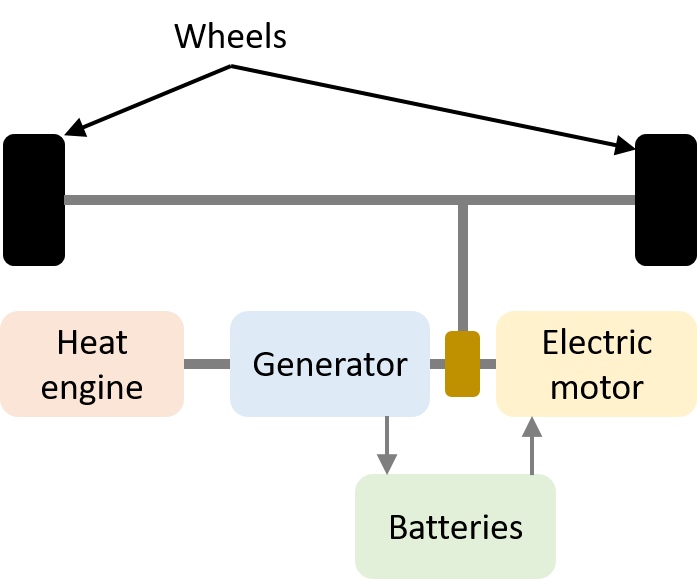
Figure 2.
Typical architecture of an HEV with full-hybridization level
2.1.4. Plug-in-Hybrid
The vehicles within this category present an architecture very similar to the full-hybrid level. However, the plug-in-hybrid has the capability of being connected to an upscale electric grid. This way, the battery system can be recharged from the traction system during breaking stages or directly from the electric system. One interesting feature of this kind of vehicle is the possibility of exploiting the on-board storage system for grid supporting tasks. For example, the vehicle batteries could be exploited as storage facilities in smart homes through bidirectional chargers, thus supporting the labor of onsite renewable generators on pursuing a more efficient energy management in dwellings[36].
2.2. Classification by Architecture
2.2.1. Series Configuration
These kinds of vehicles are also called vehicles of extended autonomy. In this case, the vehicle is driven entirely by the electric motor, which is moved by a heat engine withfuel supply. Figure 3 depicts a schematic diagram of this architecture. The mechanical output of the ICE is first converted into electricity by a generator; then, this energy could be destined to charge the batteries or propel the wheels through the electric motor, which also allows to capture the energy during braking. Thereby, the ICE is mechanically decoupled to the transmission system. This configuration allows to operate the ICE efficiently, since its torque and speed are independent of the mechanical demand of the vehicle. Hence, the ICE can be operated at any point of its characteristics. This way, the vehicle generally works at those operating points by which consumption and emissions are minimal. By this configuration, the battery system acts an accumulator facility that can store the excess of energy thus allowing to disconnect the ICE momentarily. This principle is normally handled by energy management programs, which continuously control the state of charge of the batteries on pursuing a fuel consumption reduction [37].
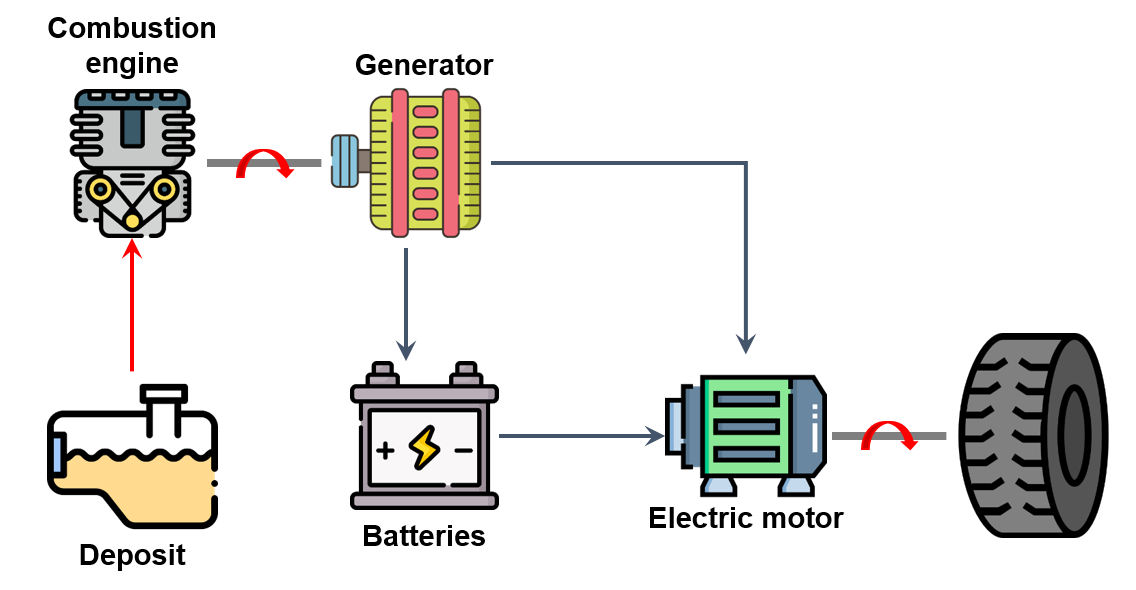
Figure 3.
Series configuration of a HEV
2.2.2. Paralell configuration
y this configuration, both the heat and electric engines can propel the transmission systems. An electric hybrid vehicle with the parallel configuration has the ICE and electric motor coupled to the final drive axle of the wheels via clutches. Moreover, this configuration allows the ICE and electric motor to supply power to drive the wheels in combined or isolated modes. This way, both systems work in parallel.
Figure 4
shows the schematic diagram of the parallel configuration for HEVs. This configuration supposes a remarkable simplification of the series architecture as the electric generator is no longer necessary. In this sense, the electric motor could work in reverse mode, converting the kinetic energy of the transmission system to electricity which is stored in batteries. Generally, ICE size can be reduced reduce with respect to the series configuration
[37]
. 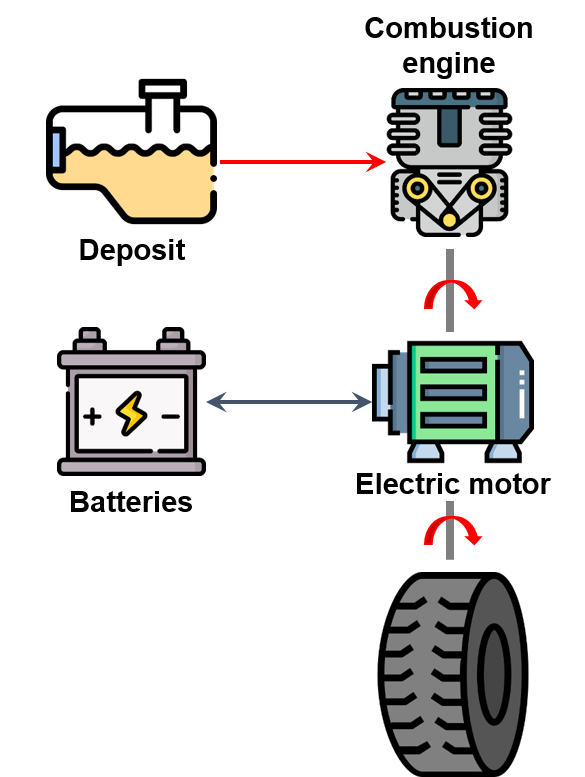
Figure 4.
Paralell configuration of a HEV
2.2.3. Mixed configuration
In essence, this configuration combines both previous architectures on a whole. This way, the vehicle could be propelled in this case through the ICE, the electric motor or bothsystems at once [37]. The heat engine is directly connected to the transmission system and is mechanically coupled to the electric system through a differential set, which mechanically couples both electric and heat systems. The electric system is composed by a motor anda generator, which allows to convert the excess of energy produced by the ICE during raking into electricity to be stored in batteries. By far, this configuration is more complex than the others, but allows to gather all the advantages obtained with series and parallel configurations. Figure 5 presents a diagram of the mixed configuration for HEVs.
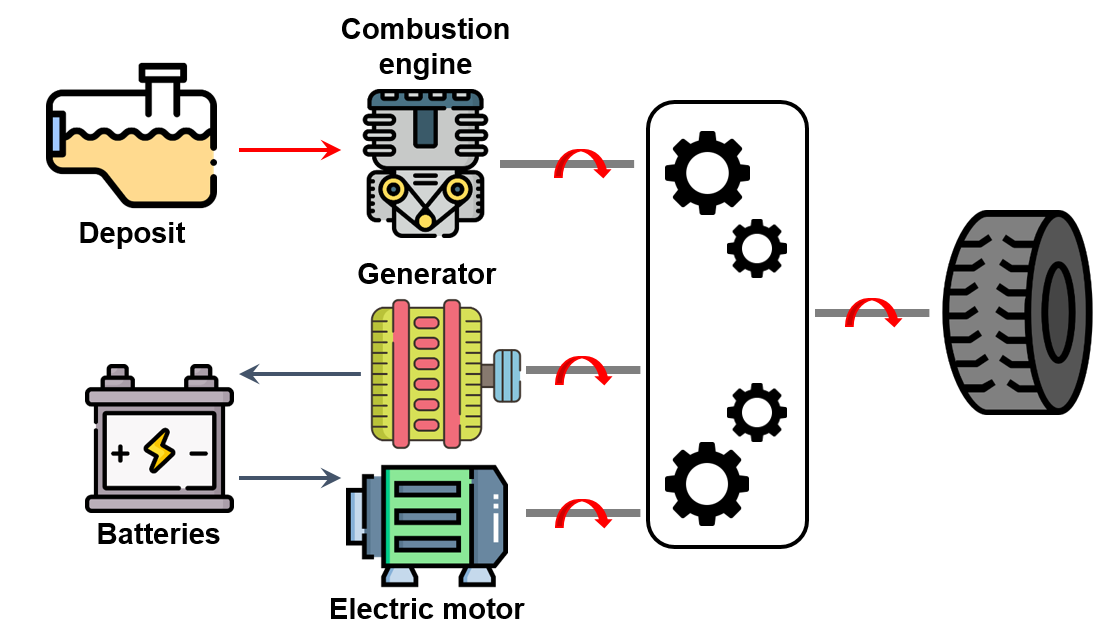
Figure 5.
Mixed configuration of a HEV
3. Typical Thermodynamic Cycles for HEVs
3.1. Otto Cycle
his cycle is associated with the ignition process that happens in the heat engine. In the literature, this cycle is also called Spark ignition. Figure 6 shows the ?/? scheme of the Otto cycle whose main steps are:
- Adiabatic compression (1–2): compression of the working fluid, the piston has to per-form the work ?1.
- Contribution of heat at constant volume (2–3): instantaneous introduction of the heat ?1 is provided.
- Adiabatic expansion (3–4): expansion, which is corresponding to the ?2 work, performed by the working fluid.
- Extraction of heat at constant volume (4–5): instantaneous extraction of ?2 heat.
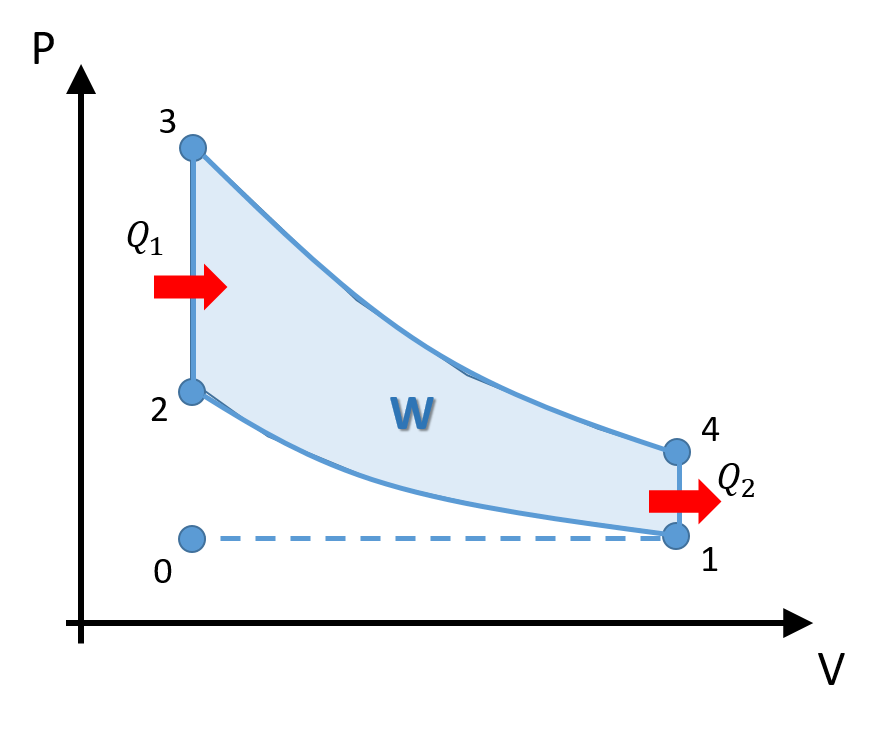 Figure 6.
Figure 6.
?/? diagram of the Otto Cycle
In the engines of four strokes (4T), the extraction of heat occurs in the exhaust phase,from the opening of the exhaust valve (4–1–0). In addition, the mixture of the air–fuel fluidis introduced into the intake stroke (0–1). This process is graphically represented in the horizontal dashed line of the p/V diagram of Figure 6. Theoretically the processes (1–0 and 0–1) between them are cancelled out, in such a way that a loss or gain of zero heat is generated, so that the p/V diagram of the ideal Otto cycle only considers the closed cycle. Similarly, the work in this phase is zero,W2−3=0 the heat supply is performed at constant Q1volume[38][39].
3.2. Atkinson Cycle
The vast majority of hybrid electric vehicles use the Atkinson cycle for internal com-bustion engines because its higher efficiency. This cycle is characterized by having a longer expansion stroke than the compression one, thus largely managing the energy available in the injected fuel. In this way, the mixture has more time to expand andproduces within the combustion chamber a greater amount of work [40]. The Atkinson cycle is relatively ideal for a hybrid vehicle since the internal combustion engine with this cycle has greater efficiency in thermal energy, but at the cost of low power [40]. In this regard, an electric motor is generally needed to complement the heat engine. Figure 7 depicts the p/V diagram of the Atkinson cycle, which comprises an adiabatic compression (1–2), addition of isochoric heat (2–3), an adiabatic expansion (3–4) and finally isobaric heatextraction.

Figure 7.
?/? diagram of the Atkinson Cycle
3.3. Miller Cycle
The Miller cycle is used in those hybrid vehicles in which the lack of torque from the engine is compensated by the addition of the electric motor. In the Miller cycle a larger cylinder than usual is usually used. The compression stroke is shortened in conjunction with the expansion stroke, where, as the piston moves upwards in the compression stroke the load is pushed out of the normally closed valve [41]. Delaying the closing time of the intake valves causes the temperature of the mixture to be reduced as well as the load mixture fraction. Consequently, the indicated effective average pressure and net cyclic work is reduced [42]. To solve this issue, a variable valve timing mechanism could be used to increase the efficiency of the Miller cycle. Figure 8 plots the p/V diagram of the Miller cycle which comprises an adiabatic compression (1–2), addition of isochoric heat (2–3), an adiabatic expansion (3–4), elimination of isochoric heat (4–5) and elimination of isobaric heat (5–1).
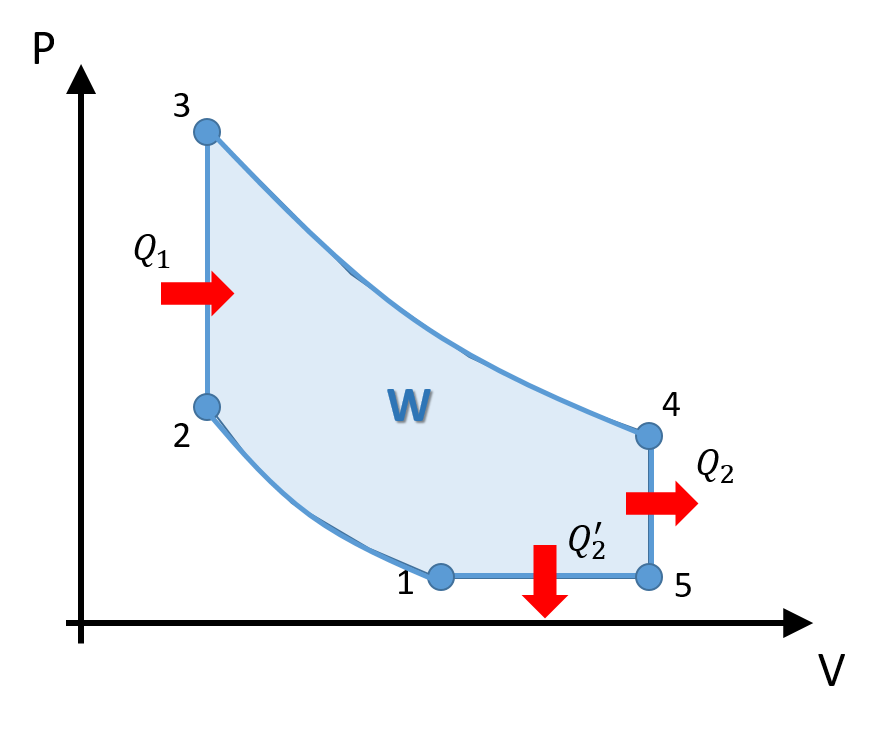
Figure 8. ?/? diagram of the Miller Cycle
?/? diagram of the Miller Cycle
Acknowledgements
References
- Choma, E.F.; Evans, J.S.; Hammitt, J.K.; Gómez-Ibáñez, J.A.; Spengler, J.D. Assessing the health impacts of electric vehicles through air pollution in the United States. Environ. Int. 2020, 144, 106015.
- Cárcel-Carrasco, J.; Pascual-Guillamón, M.; Salas-Vicente, F. Analysis on the Effect of the Mobility of Combustion Vehicles in the Environment of Cities and the Improvement in Air Pollution in Europe: A Vision for the Awareness of Citizens and Policy Makers. Land 2021, 10, 184.
- Yang, X.; Lin, W.Q.; Gong, R.X.; Zhu, M.Z.; Springer, C. Transport decarbonization in big cities: An integrated environmental co-benefit analysis of vehicles purchases quota-limit and new energy vehicles promotion policy in Beijing. Sustain. Cities Soc. 2021, 71, 102976.
- Xie, Y.; Wu, D.; Zhu, S. Can new energy vehicles subsidy curb the urban air pollution? Empirical evidence from pilot cities in China. Sci. Total Environ. 2021, 754, 142232.
- Pini, F.; Piras, G.; Garcia, D.A.; Di Girolamo, P. Impact of the different vehicle fleets on PM10 pollution: Comparison between the ten most populous Italian metropolitan cities for the year 2018. Sci. Total Environ. 2021, 773, 145524.
- Zhao, J.; Xi, X.; Na, Q.; Wang, S.; Kadry, S.N.; Kumar, P.M. The technological innovation of hybrid and plug-in electric vehicles for environment carbon pollution control. Environ. Impact Assess. Rev. 2021, 86, 106506.
- Breuer, J.L.; Samsun, R.C.; Stolten, D.; Peters, R. How to reduce the greenhouse gas emissions and air pollution caused by light and heavy duty vehicles with battery-electric, fuel cell-electric and catenary trucks. Environ. Int. 2021, 152, 106474.
- Alla, S.A.; Bianco, V.; Tagliafico, L.A.; Scarpa, F. Pathways to electric mobility integration in the Italian automotive sector. Energy 2021, 221, 119882.
- Ajanovic, A.; Haas, R.; Schrodl, M. On the Historical Development and Future Prospects of Various Types of Electric Mobility. Energies 2021, 14, 1070.
- Torreglosa, J.P.; Garcia-Trivino, P.; Vera, D.; Lopez-Garcia, D.A. Analyzing the Improvements of Energy Management Systems for Hybrid Electric Vehicles Using a Systematic Literature Review: How Far Are These Controls from Rule-Based Controls Used in Commercial Vehicles? Appl. Sci. 2020, 10, 8744.
- Clifford, J. History of the Toyota Prius. Toyota UK Mag. 2015. Available online: (accessed on 2 June 2021).
- Kim, N.; Rousseau, A. Thermal impact on the control and the efficiency of the 2010 Toyota Prius hybrid electric vehicle. Proc. Inst. Mech. Eng. Part D J. Automob. Eng. 2016, 230, 82–92.
- Jin, Y.N.; Andersson, H.; Zhang, S.Q. Air Pollution Control Policies in China: A Retrospective and Prospects. Int. J. Environ. Res. Public Health 2016, 13, 1219.
- Tostado-Véliz, M.; Bayat, M.; Ghadimi, A.A.; Jurado, F. Home Energy Management in off-grid Dwellings: Exploiting Flexibility of Thermostatically Controlled Appliances. J. Clean. Prod. 2021, 310, 127507.
- U. S. Department of Energy. Fuel Economy Guide. 2021. Available online: (accessed on 15 July 2021).
- IDAE. Guía para la Promoción del Vehículo Eléctrico en las Ciudades; IDAE: Madrid, Spain, 2011. Available online: (accessed on 2 June 2021).
- Adhikari, M.; Ghimire, L.P.; Kim, Y.; Aryal, P.; Khadka, S.B. Identification and Analysis of Barriers against Electric Vehicle Use. Sustainability 2021, 12, 4850.
- Endesa, X. 7 Differences between an Electric Vehicle and a Plug-In Hybrid. Available online: (accessed on 15 July 2021).
- Cao, J.F.; He, H.W.; Wei, D. Intelligent SOC-consumption allocation of commercial plug-in hybrid electric vehicles in variable scenario. Appl. Energy 2021, 281, 115942.
- Hajipour, E.; Mohiti, M.; Farzin, N.; Vakilian, M. Optimal distribution transformer sizing in a harmonic involved load environment via dynamic programming technique. Energy 2017, 120, 92–105.
- Zhao, Y.; He, X.; Yao, Y.; Huang, J.J. Plug-in electric vehicle charging management via a distributed neurodynamic algorithm. Appl. Soft Comput. 2019, 80, 557–566.
- Alegre, S.; Míguez, J.V.; Carpio, J. Modelling of electric and parallel-hybrid electric vehicle using Matlab/Simulink environment and planning of charging stations through a geographic information system and genetic algorithms. Renew. Sustain. Energy Rev. 2017, 74, 1020–1027.
- Kumar, P.R.; Shankar, C.G.; Uthirasamy, R.; Vijayalakshmi, V.J. A Review of Electric Vehicle Technologies. In Proceedings of International Conference on Artificial Intelligence, Smart Grid and Smart City; Kumar, L.A., Jayashree, L.S., Manimegalai, R., Eds.; Springer: New York, NY, USA, 2019.
- España 2050: Aumento de Impuestos a la Gasolina y al Diésel y una Tasa por el uso Del Vehículo. Heraldo updated 27 May 2021. Available online: (accessed on 2 June 2021).
- Arévalo, P.; Tostado-Véliz, M.; Jurado, F. A Novel Methodology for Comprehensive Planning of Battery Storage Systems. J. Energy Storage 2021, 37, 102456.
- Hilgers, M.; Achenbach, W. Alternative Powertrains and Extensions to the Conventional Powertrain; Springer Vieweg: Wiesbaden, Germany, 2021; pp. 17–41.
- Harper, G.; Sommerville, R.; Kendrick, E.; Driscoll, L.; Slater, P.; Stolkin, R.; Walton, A.; Christensen, P.; Heidrich, O.; Lambert, S.; et al. Recycling lithium-ion batteries from electric vehicles. Nature 2019, 575, 75–86.
- Zu, C.-X.; Li, H. Thermodynamic analysis on energy densities of batteries. Energy Environ. Sci. 2011, 4, 2614–2624.
- Van Noorden, R. The rechargeable revolution: A better battery. Nature 2014, 507, 26–28.
- Cano, Z.P.; Banham, D.; Ye, S.; Hitennach, A.; Lu, J.; Fowler, M.; Chen, Z. Batteries and fuel cells for emerging electric vehicle markets. Nat. Energy 2018, 3, 279–289.
- Dimitrova, Z. Predictive and holistic energy distribution for hybrid electric vehicles. MATEC Web Conf. 2017, 133, 02002.
- Dimitrova, Z. Performance and economic analysis of an organic Rankine Cycle for hybrid electric vehicles. IOP Conf. Ser. Mater. Sci. Eng. 2019, 664, 012009.
- Capata, R.; Scuibba, E. Study, Development and Prototyping of a Novel Mild Hybrid Power Train for a City Car: Design of the Turbocharger. Appl. Sci. 2020, 11, 234.
- Capata, R. Preliminary Analysis of a New Power Train Concept for a City Hybrid Vehicle. Designs 2021, 5, 19.
- Mapelli, F.L.; Tarsitano, D. Energy control for Plug-In HEV with ultracapacitors lithium-ion batteries storage system for FIA Alternative Energy Cup Race. In Proceedings of the 2010 IEEE Vehicle Power and Propulsion Conference, Lille, France, 1–3 September 2010; pp. 1–6.
- Marcos Tostado-Véliz; Rogelio S. León-Japa; Francisco Jurado; Optimal electrification of off-grid smart homes considering flexible demand and vehicle-to-home capabilities. Applied Energy 2021, 298, 117184, 10.1016/j.apenergy.2021.117184.
- Onori, Simona; Serrao, Lorenzo; Rizzoni, Giorgio. Hybrid Electric Vehicles: Energy Management Strategies; Onori, Simona; Serrao, Lorenzo; Rizzoni, Giorgio, Eds.; Springer: Berlin-Heideberg, 2016; pp. 1-1.
- Marcos Tostado-Véliz; Paul Arévalo; Francisco Jurado; A comprehensive electrical-gas-hydrogen Microgrid model for energy management applications. Energy Conversion and Management 2020, 228, 113726, 10.1016/j.enconman.2020.113726.
- Pranoti Gathadi; A. Bhole; Electric Motors and Rotor Position Detection Techniques of Integrated Starter Alternator for HEV: A Review. 2018 International Conference on Current Trends towards Converging Technologies (ICCTCT) 2018, 1, 1-6, 10.1109/icctct.2018.8551032.
- Roberto Capata; Urban and Extra-Urban Hybrid Vehicles: A Technological Review. Energies 2018, 11, 2924, 10.3390/en11112924.
- E. D. Tate; Michael O. Harpster; Peter J. Savagian; The Electrification of the Automobile: From Conventional Hybrid, to Plug-in Hybrids, to Extended-Range Electric Vehicles. SAE International Journal of Passenger Cars - Electronic and Electrical Systems 2008, 1, 156-166, 10.4271/2008-01-0458.
- I. A. Kulikov; L. Yu. Lezhnev; S. V. Bakhmutov; Comparative Study of Hybrid Vehicle Powertrains with Respect to Energy Efficiency. Journal of Machinery Manufacture and Reliability 2019, 48, 11-19, 10.3103/s1052618819010102.
